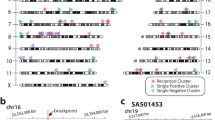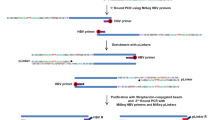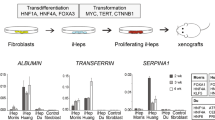Abstract
THE recent finding of c-myc activation by insertion of woodchuck hepatitis virus DNA in two independent hepatocellular carcinoma1 has given support to the hypothesis that integration of hepatitis B viruses into the host genome, observed in most human and woodchuck liver tumours2,3, might contribute to oncogenesis. We report here high frequency of woodchuck hepatitis virus DNA integrations in two newly identified N-myc genes: N-myc1, the homologue of known mammalian N-myc genes, and N-myc2, an intronless 'complementary DNA gene' or 'retroposon' that has retained extensive coding and transforming homology with N-myc. N-myc2 is totally silent in normal liver, but is overexpressed without genetic rearrangements in most liver tumours. Moreover, viral integrations occur within either N-myc1 or N-myc2 in about 20% of the tumours, giving rise to chimaeric messenger RNAs in which the 3' untranslated region of N-myc was replaced by wood-chuck hepatitis virus sequences encompassing the viral enhancer. Insertion sites were clustered in a short sequence of the third exon that coincides with a retroviral integration hotspot within the murine N-myc gene, recently described in T-cell lymphomas induced by murine leukaemia virus4–6. Thus, comparable mechan-isms, leading to deregulated expression of N-myc genes, may operate in the development of tumours induced either by hepatitis virus or by nonacute retroviruses in rodents. Activation of myc genes by insertion of hepadnavirus DNA now emerges as a common event in the genesis of woodchuck hepatocellular carcinoma.
This is a preview of subscription content, access via your institution
Access options
Subscribe to this journal
Receive 51 print issues and online access
$199.00 per year
only $3.90 per issue
Buy this article
- Purchase on Springer Link
- Instant access to full article PDF
Prices may be subject to local taxes which are calculated during checkout
Similar content being viewed by others
References
Hsu, T. Y. et al. Cell 55, 627–635 (1988).
Tiollais, P., Pourcel, C. & Dejean, A. Nature 317, 489–495 (1985).
Ganem, D. & Varmus, H. E. A. Rev. Biochem. 56, 651–693 (1987).
Van Lohuizen, M., Breuer, M. & Berns, A. EMBO J. 8, 133–136 (1989).
Dolcetti, R. et al. Oncogene 4, 1009–1014 (1989).
Setoguchi, M. et al. Molec. cell. Biol. 9, 4515–4522 (1989).
Kohl, N. E. et al. Nature 319, 73–77 (1986).
Stanton, L. W., Schwab, M. & Bishop, J. M. Proc. natn. Acad. Sci. US.A. 83, 1772–1776 (1986).
De Pinho, R. A. et al. Proc. natn. Acad Sci. U.S.A. 83, 1827–1831 (1986).
Stanton, L. W. & Bishop, J. M. Molec. cell. Biol. 7, 4266–4272 (1987).
Vanin, E. F. A. Rev. Genet. 19, 253–272 (1985).
Mäkelä, T. P., Saksela, K. & Alitalo, K. Molec. cell. Biol. 9, 1545–1552 (1989).
Struhl, K. Cell 49, 295–297 (1987).
Rechsteiner, M., Rogers, S. & Rote, K. Trends biochem. Sci. 12, 390–394 (1987).
Mure, C., McCaw, P. S. & Baltimore, D. Cell 56, 777–783 (1989).
Prendergast, G. C. & Ziff, E. B. Nature 341, 392 (1989).
Dang, C. V., McGuire, M., Buckmire, M. & Lee, W. M. F. Nature 337, 664–666 (1989).
Nakajima, H., Ikeda, M., Tsuchida, N., Nishimura, S. & Taya, Y. Oncogene 4, 999–1002 (1989).
Land, H., Parada, L. F. & Weinberg, R. A. Nature 304, 596–602 (1983).
Schwab, M., Varmus, H. E. & Bishop, J. M. Nature 316, 160–162 (1985).
Yancopoulos, G. D. et al. Proc. natn. Acad. Sci. U.S.A. 82, 5455–5459 (1985).
Shih, C. & Weinberg, R. A. Cell 29, 161–169 (1982).
Land, H., Chen, A. C., Morgenstein, J. P., Parada, L. F. & Weinberg, R. A. Molec. cell. Biol. 6, 1917–1925 (1986).
Shaul, Y., Rutter, W. J. & Laub, O. EMBO J. 4, 427–430 (1985).
Robinson, M. O., McCarrey, J. R. & Simon, M. I. Proc. natn. Acad Sci. USA. 86, 8437–8441 (1989).
Ashworth, A., Skene, B., Swift, S. & Lovell-Badge, R. EMBO J. 9, 1529–1534 (1990).
McCarrey, J. R. & Thomas, K. Nature 326, 501–505 (1987).
Sugiyama, A. et al. Proc. natn. Acad. Sci. U.S.A. 86, 9144–9148 (1989).
Kekulé, A. S. et al. Nature 343, 457–461 (1990).
Wollersheim, M., Debelka, U. & Hofschneider, P. H. Oncogene 3, 545–552 (1988).
Chisari, F. V. et al. Cell 59, 1145–1156 (1989).
Dejean, A., Bougueleret, L., Grzeschik, K. H. & Tiollais, P. Nature 322, 70–72 (1986).
Wang, J., Chenivesse, X., Henglein, B. & Bréchot, C. Nature 343, 555–557 (1990).
Galibert, F., Chen, T. & Mandart, E. J. Virol. 39, 447–454 (1982).
Sanger, F., Nicklen, S. & Coulson, A. R. Proc. natn. Acad. Sci. U.S.A. 74, 5463–5467 (1977).
Deininger, P. L. Analyt. Biochem. 129, 216–233 (1983).
Kawasaki, E. S. et al. Proc. natn. Acad. Sci. US.A. 85, 5698–5702 (1988).
Church, G. M. & Gilbert, W. Proc. natn. Acad. Sci. U.S.A. 81, 1991–1995 (1984).
Author information
Authors and Affiliations
Rights and permissions
About this article
Cite this article
Fourel, G., Trepo, C., Bougueleret, L. et al. Frequent activation of N-myc genes by hepadnavirus insertion in woodchuck liver tumours. Nature 347, 294–298 (1990). https://doi.org/10.1038/347294a0
Received:
Accepted:
Issue Date:
DOI: https://doi.org/10.1038/347294a0
This article is cited by
-
Medical Virology of Hepatitis B: how it began and where we are now
Virology Journal (2013)
-
Hepatitis B virus-related insertional mutagenesis in chronic hepatitis B patients as an early drastic genetic change leading to hepatocarcinogenesis
Oncogene (2005)
-
Integrations of the hepatitis B virus (HBV) and human papillomavirus (HPV) into the human telomerase reverse transcriptase (hTERT) gene in liver and cervical cancers
Oncogene (2003)
Comments
By submitting a comment you agree to abide by our Terms and Community Guidelines. If you find something abusive or that does not comply with our terms or guidelines please flag it as inappropriate.



